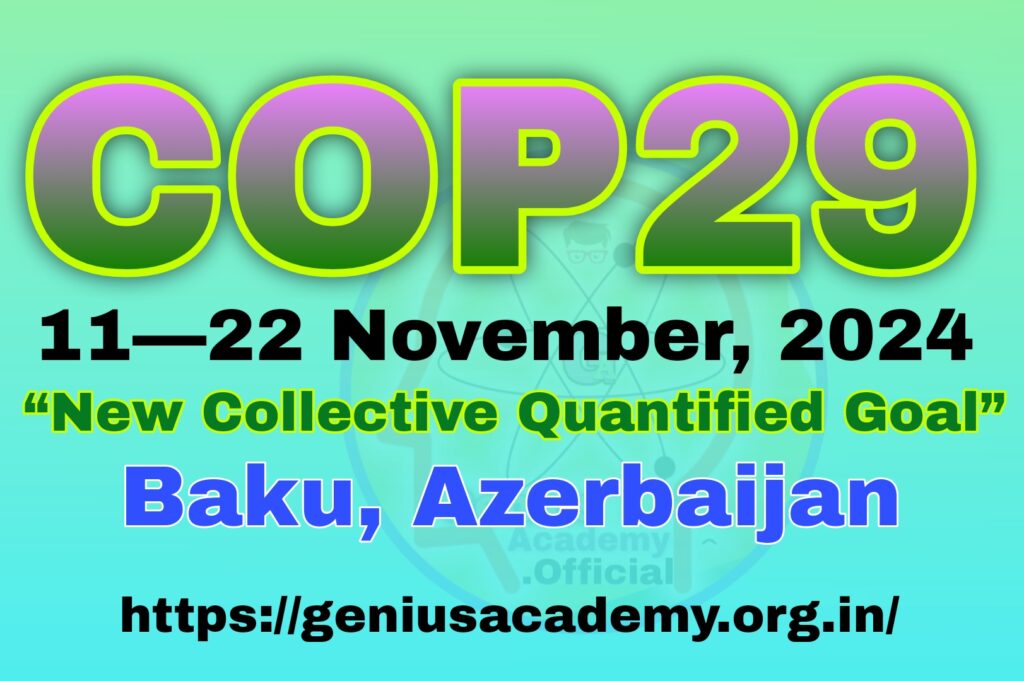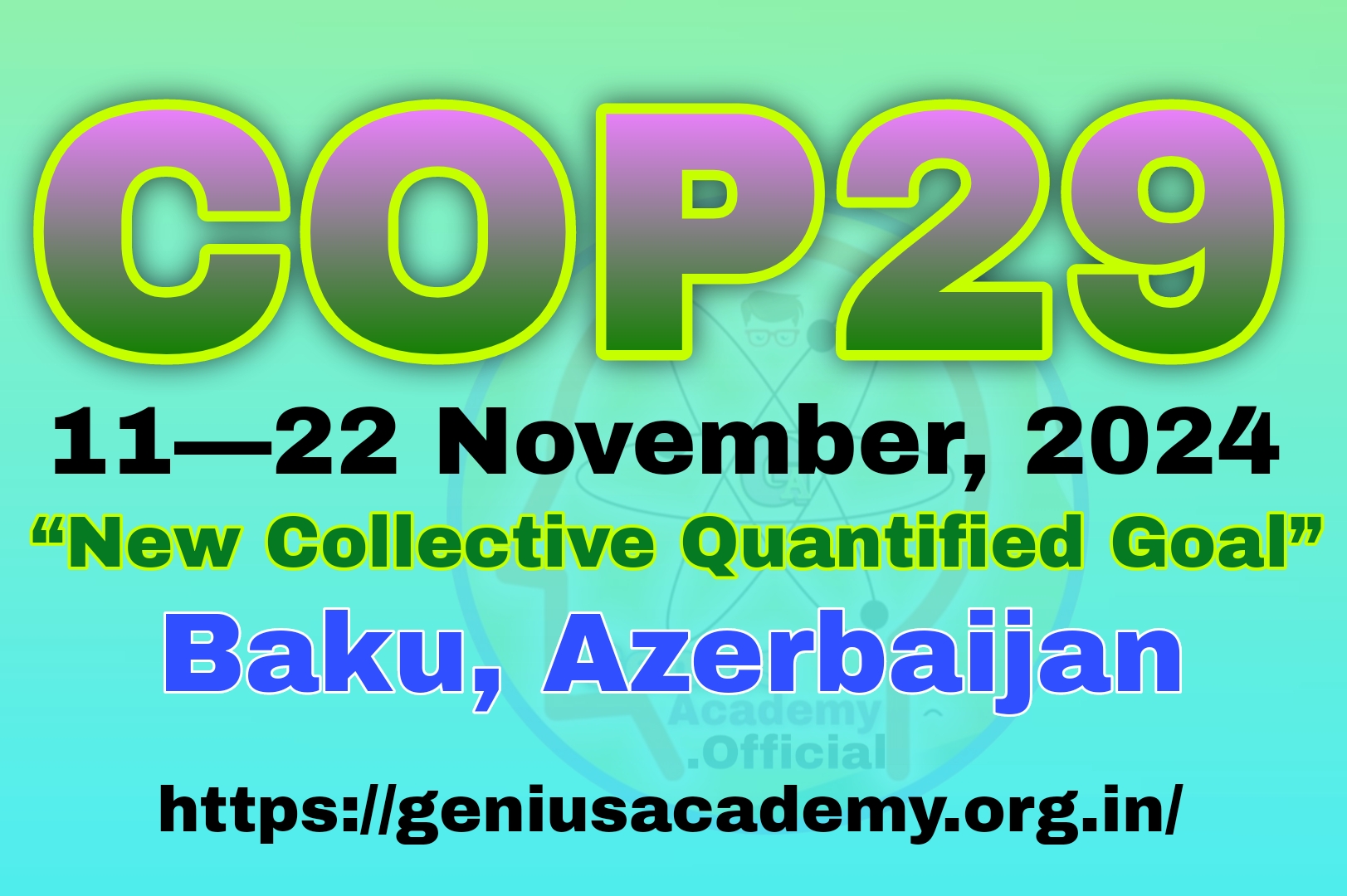
Zeroing in on Methane Diplomacy: India’s Role at COP29
Context
The upcoming 29th Conference of the Parties (COP29) to the United Nations Framework Convention on Climate Change (UNFCCC) will bring world leaders to Baku, Azerbaijan, from November 11 to 22, 2024. Dubbed the “Finance COP,” this event will set a new global climate finance goal, known as the “new collective quantified goal” (NCQG). This year’s COP is particularly significant as methane emission reduction takes center stage, with Azerbaijan, the host country, putting forth initiatives to cut methane from organic waste and expand clean energy solutions. This presents India with an opportunity to position itself as a leader in methane mitigation, given the global attention on this potent greenhouse gas.
Why Methane Matters in Climate Action
Methane is responsible for approximately 30% of global warming since the pre-industrial era, and its concentration in the atmosphere continues to rise. Methane has a significant global warming potential (GWP) compared to carbon dioxide—28 times more potent over a 100-year timescale and 84 times more powerful over a 20-year timescale. Thus, reducing methane emissions can help slow temperature rises in the near term, allowing more time to implement longer-term CO₂ reduction strategies essential for stabilizing the climate.
U.S.-China Collaboration on Methane Emission Reduction
Despite geopolitical tensions, the United States and China have found common ground on methane reduction. In 2023, at COP28 in Dubai, they co-sponsored a summit focused on non-CO₂ emissions, with the United Arab Emirates. That same year, China introduced its first national methane control plan, emphasizing capacity-building measures over specific targets. While the plan does not include explicit methane reduction goals, it represents China’s commitment to addressing methane as a climate issue. For India, the U.S.-China methane collaboration presents an opportunity to secure sector-specific financial and technical support, leveraging the momentum for methane mitigation.
Methane Emissions in India: Current Status and Challenges
India is the world’s third-largest emitter of anthropogenic methane, with emissions largely stemming from agriculture, waste, and energy production. According to India’s Third Biennial Update Report to the UNFCCC, the country emitted 409 million tons of CO₂-equivalent methane in 2016. Breakdown by sector reveals that:
- Agriculture:— Accounts for 74% of emissions, primarily from rice cultivation and livestock.
- Waste:— Responsible for 14% of emissions, with waste dumpsites being a significant source.
- Energy:— Contributes 11% to total emissions.
- Industrial Processes:— Account for about 1%.
Methane’s impact extends beyond climate change; for instance, fires in waste dumpsites contribute to significant air pollution spikes. In 2022, a fire at Delhi’s Bhalswa dumpsite increased particulate matter by 30% to 70% above baseline levels. However, India’s high dependence on agriculture makes it cautious about adopting broad methane reduction targets, as efforts would significantly impact sectors like livestock and rice farming.
The Global Methane Pledge and India’s Stance
Launched at COP28, the Global Methane Pledge, led by the U.S. and the European Union, aims to cut methane emissions by 30% from 2020 levels by 2030. However, India has not joined the pledge due to concerns about the agricultural sector’s dependence on livestock and rice cultivation, which are major sources of methane. Nevertheless, India can explore sector-specific collaborations, particularly in waste management, where methane reduction is achievable without major agricultural trade-offs.
Methane Mitigation in India: Existing Initiatives and Strategies
India has made progress in methane reduction through several initiatives, particularly in waste management and agriculture.
1. Waste Management Programs
- Model Cities:— Indore, Madhya Pradesh, serves as a model for organic waste management, implementing citywide waste sorting and operating a biomethane plant that fuels buses.
- GOBARdhan Scheme:— This initiative incentivizes the use of cattle waste for clean energy production in rural areas. It aligns with the Swachh Bharat Mission-Urban 2.0, which aims to improve solid waste management nationwide.
- Scaling Needs:— While India has strong regulatory frameworks for waste management, limited local capacity hinders widespread adoption. Increased support could help scale up organic waste management projects across the country.
_
2. Agricultural Emission Reductions
- National Mission for Sustainable Agriculture (NMSA):— The NMSA promotes climate-resilient agricultural practices, including methane-reduction techniques in rice farming.
- National Livestock Mission:— This mission encourages practices like green fodder production and mixed rations, which can reduce methane emissions from livestock. By improving livestock diets, the mission aims to enhance both productivity and environmental sustainability.
_
Leveraging U.S.-China Cooperation for India’s Methane Diplomacy
India can capitalize on the U.S.-China methane partnership to access international support for methane reduction. By aligning with this global focus, India can negotiate for sector-specific financing, technical assistance, and capacity-building support to implement methane reduction measures in the waste management sector, which contributes over 14% of the country’s methane emissions. This approach would allow India to address methane emissions without major disruptions to its agricultural economy.
_
Methane Diplomacy at COP29
Methane may not be the primary agenda at COP29, yet it presents an invaluable opportunity for India to advance its climate goals. The groundwork has been laid through national programs and initiatives, but scaling these solutions requires increased international support. By actively participating in methane-focused discussions at COP29, India can position itself as a leader in climate action while securing the resources necessary to meet its methane mitigation targets. This strategic focus aligns with India’s broader climate objectives and strengthens its role in global methane diplomacy.
#Zeroing in on Methane Diplomacy
#Zeroing in on Methane Diplomacy
_
Zeroing in on Methane Diplomacy
Zeroing in on Methane Diplomacy

